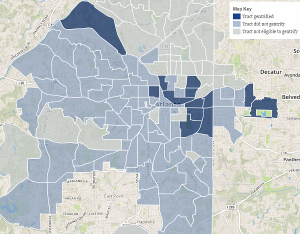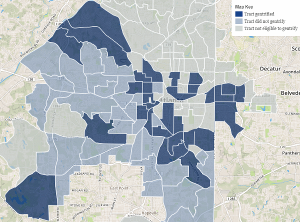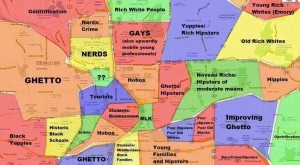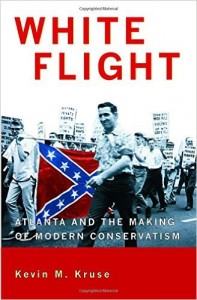Apr
2016
Annotated Bibliographies #1-10
Annotated Bibliography 1:
“An Atlanta Neighborhood Tries To Redefine Gentrification.”Frontiers of Race, Culture and Ethnicity. Code Switch, 23 Sep 2015. Web. 04 Feb 2016. <http://www.npr.org/sections/codeswitch/2015/09/23/435293852/an-atlanta-neighborhood-tries-to-redefine-gentrification>.
This article discusses how the east lake golf club that sits in a neighborhood that once was in the middle full of crime, poverty and public housing projects ,and a Golf course with dry patchy land where golfers risked the case of a stray bullet, but is now a PGA tour stop due to the redevelopment and Golf Club. The neighborhood was so full of trouble and crime that it was known as the war zone and nick named “Little Vietnam”. It discusses how the crime rate was 18 times the national average. The article talks about how the golf club helped reestablish the community by being a source of funds and support. Although the intentions of the reconstruction was to create mixed-income housing to go along with schools, child care and jobs of quality article discusses how the some people were forced out of the new found transformed neighborhood due to certain requirements.
I think this article is important because it gives insight from the residents who once belonged to that community before the gentrification. This article provides so much history on what East Lake neighborhoods were like and how deprived and forsaken they were. It provides information on how the changes began and the effects of those changes. Whether good or bad, it gave testimonies on how it affected those looking for a stable safe place to live and raise families and also those who were forced to remove themselves due to those new requirements.
Annotated Bibliography 2:
Deirdre A. Oakley. “ASA Footnotes: A Publication of American Sociological Association.” Annual Meeting Premieres The Atlanta Way: A Documentary on Gentrification. ASA, Jul 2010. Web. 2 Feb 2016. <http://www.asanet.org/footnotes/julyaugust10/am_0710.html>.
This article is a profound one.it talks about the first premiere of the documentary. It also discusses the contradictory effects of the gentrification of the Atlanta neighborhoods that has been taken place and causing the predominantly poor black neighborhoods more suitable for affluent white people who can afford the upgraded living areas. It had great details about the purpose of the film with several interviews including Professor Deirdre A. Oakley. She expressed her opinion with great knowledge of what has been taking place in Atlanta residence. She summarizes her views of how this is creating a less diverse environment and how one sided the benefits are for those who can afford to remain or move to Atlanta.
She gives details and information about the writer of the film, King Williams in an interview segment that wouldn’t likely be found anywhere else.it allowed him to tell his story and give us a view of what was in his mind when he created the film and what inspired him to do so.
This article is a great resource for capturing the highlights of the film and to get insight on what gentrification is and how homelessness and displacement occurred in our city. Through this site, there lies more information about gentrification and how it’s like a two sided coin and were only looking at the side that is turned up our way.
Annotated Bibliography 3:
Max Blau. “Creative Loafing.” Can Anyone Stop Atlanta’s Gentrification. 13 Feb 2015. Web. 04 Feb 2016. http://clatl.com/freshloaf/archives/2015/02/03/can-anyone-stop-atlantas-rapid-gentrification.
Can Anyone Stop Atlanta’s Gentrification is a detailed article that has maps describing and illustrating the gentrification process since the 1990s and now the most recent map of 2015. The maps are vivid, well researched and informative.
The article provides a lot of documentation on what has been happening nationally to gentrify our cities. The author states that gentrification is happening but it is also causing our neighborhoods to become more affluent driving out the previous residents that were predominantly black. The article begs the question of what is actually happening to those who previously resided in these project homes now turned lofts and condos. This also leaves us to the bigger question, is this really a good thing and if possible is there any way to stop the gentrification. This article has statements from Mayor Kasim Reed and other government officials and their views of the rapid gentrification.
This source provides helpful information on the gentrification and illustrations showing how Atlanta is gentrifying twice as fast than any other city in America. It also discusses census data for 50 of the nation’s largest cities, which was published by Governing This Month.
Annotated Bibliography #4
Bracey , Trayon . “The Big Discussion with Gentrification in Atlanta .” The Lifestyle Room . 20 Jan 2016. Web. 24 Feb 2016. <http://artrevmagazine.weebly.com/lifestyle/the-big-discussion-with-gentrification-in-atlanta.
The Big Discussion with Gentrification is a topic discussed with Travon Bracey published by The Atriv Magazine in the Lifestyle section. This article discusses His personal experiences of living in Atlanta and how gentrification has affected him and black culture as a whole in terms of socially, financially, politically, mentally and also educationally.
He discusses his experiences in the East Lake neighborhood as a child growing up, he reflects back on his memories of living in these neighborhoods and all the good memories he once shared there, with the people, the inspiring graffiti walled art,(what we may think is gang related), just everything in the environment that creates black culture. He discusses the differences in the community from then to now. He makes a lot of valid points in my opinon…
This article goes to show that even though Tom Cousins and other investors who helped clean up the neighborhood, bringing about a change, completely transforming the neighborhoods, may have very well did everything that they did with GREAT intentions for us all, but not everyone sees it that way and Travon is just one of those people who decided to speak on his views on how gentrification erased the historical and sentimental meaning of the black culture in those neighborhoods, by mixing them or completely taking them over making them unrecognizable to what some used to call home.
This article was an insightful, just to be able to read another side of a story of someone who views the former East Lake neighborhood as something more than a drug filled, crime raised, dead cop zone.
Annotated Bibliography #5
“PBS Newshour.” Chasing the Dream: Poverty and Opportunity in America. PBS, 09 May 2015. Web. 22 Feb 2016. http://www.pbs.org/newshour/bb/can-u-s-break-clusters-poverty-roiling-south/.
Chasing the Dream: Poverty and Opportunity in America is described as a multi-platform public media initiative that provides a deeper understanding of the impact of poverty on American society. This article, which I saw as the complete opposite of “The Big Discussion of Gentrification of Atlanta by Travon Bracey.
This platform allows Jimmy Williams, who after prison dedicated his life to improving poverty driven neighborhoods, to tell his story on how he was caught up dealing drugs in the East Lake community. He describes the toughness of the town and the difficulties to succeed and how he succumbed to the streets and dealing drugs, which landed him seven years in prison and also gave him what he needed to be who he is today, to be able to help those who was once in his position and to prevent others from being there.
This platform speaks of positivity about the transformation. Through research you’ll see that there are several sides to how gentrification has affected its people who live and have lived in these neighborhoods. This article just shows that everything that Tom Cousins and the foundation, Purpose Built Communities, set out to do to improve not just the neighborhood but the community surrounded by them, did in many ways have a great impact on many people.
Annotated Bibliography #6
Felton, Carly. “Atlanta Intown .” Transformation of East Lake.Springs Publishing LLC, 01 Aug 2009. Web. 20 Feb 2016. <http://www.atlantaintownpaper.com/2009/08/the-transformation-of-east-lake/>.
The Transformation at East Lake is an article published by Carly Felting, who discusses the stats that made East Lake neighborhoods such a poverty crazed and criminalized place to live in. it gives a great visual as to why, when and how to why Tom Cousins decided to embark on the journey to transforming East Lake Atlanta’s neighborhoods, these neighborhoods that were once filled with drug dealers and lords, Tom had a vision and though it is was quite risky, it was the greatest endeavor yet. This article would we great for research because it puts numbers into the equations for greater understanding as to how rough and tough these neighborhoods were before the transformation. There are also statements provided from those who were born and raised, or those who did the raising of their children there, stating that being born and subjected to this neighborhood, they never had a chance.
The article discusses the restoration of the golf course, building of new homes, and the transformation of the community, it is very detailed with numbers and it ends with stats showing the outcome of Tom Cousins attempt to making it greater, it shows in numbers the percentage of children and families who now have a chance.
Annotated Bibliography #7
Kevin , Kruse. White Flight: Atlanta and the Making of Modern Conservatism. Princeton University Press, 2007. Print.
White Flight: Atlanta and the Making of Modern Conservatism is a book written by Kevin Kruse. It is described as “the study of white resistance to desegregation” This book discusses politics and society in the twentieth century America. You can find this book on amazon alongside several informative reviewer’s comments and excitement about this book. Although I did not read the entire book, I found the information regarding the book really insightful at the least. Through the reviews, I was able to see that the book is very easy to read and well written. This book will teach you about Atlanta and its history. It is said to be well researched and informative, and though some people may not be too fond of history and politics, Kevin Kruse did an excellent job on being able to keep your attention while revealing the truth and segregation, discrimination and white flight.
This is a review of Thomas J. Sugrue, Kahn Professor of History and Sociology, University of Pennsylvania, who is also the author of The Origins of the Urban Crisis. -“White Flight is a myth-shattering book. Focusing on the city that prided itself as ‘too busy to hate,’ Kevin Kruse reveals the everyday ways that middle-class whites in Atlanta resisted civil rights, withdrew from the public sphere, and in the process fashioned a new, grassroots, suburban-based conservatism. This important book has national implications for our thinking about the links between race, suburbanization, and the rise of the New Right.” Pretty awesome book right?
Annotated Bibliography #8
Cheney-Rice, Zak. “These Seven CIties Expose Exactly What Gentrification is Doing to America.” Identities.Mic. Mic, 2011. Web. 02 Apr 2016. <http://mic.com/articles/102004/these-7-cities-expose-exactly-what-gentrification-is-doing-to-america#.ve9STekQ6>.
This article was written by Zak Cheney-Rice, the Senior Staff writer of mic, on October 22, 2014, which was published on mic.com. I find this source to be extremely useful due to the format and layout of the site, and how easy it is to scroll through and see the numbers and percentages that are used to describe the problems and patterns of gentrification in the seven cities listed: Boston, Seattle, New York City, San Francisco, Washington D.C., Atlanta of course, and Chicago.
This site provides information that other websites may not have because it is not just based off of opinions, but facts and reality instead. While reading this article, I found myself being saddened at the reality of gentrification and how many have prospered and the expense of others and the loss of their homes and environments. Through reading, I found the article to very knowledgeable and insightful none the least. If you ever wanted to know what is going on the world, and not just Atlanta, this is the website that provides a heads up on the changes and transformations that has been happening in our very own town and others since the 1960s.
Annotated Bibliography #9
Garland, Sarah . “The Atlantic .” Rich Kid, Poor Kid: How Mixed Neighborhoods Could Save America’s Schools. The Atlantic, 25 Jul 2012. Web. 28 Mar 2016. <http://www.theatlantic.com/national/archive/2012/07/rich-kid-poor-kid-how-mixed-neighborhoods-could-save-americas-schools/260308/>.
Rich Kid, Poor Kid: How Mixed Neighborhoods Could Save America’s Schools is an article written in the online magazine: the Atlantic. It is written by Sarah Garland and was published on July 25, 2012. This article discusses the the question: “ In a former Atlanta slum, low- and middle-income families now live side by side — and send their children to the same excellent school. Is this surprising model too good to be true?”
This article discusses integration in a Charter school in East Lake Atlanta, Charles Drew Charter School. It gives the testimony of Theresa Cartwright and her experiences in the public school system during the “little Vietnam days” and how her mom transferred her and gave her a better opportunity and life while her fellow classmates traveled the road of public assistance. She goes to mention how over the years, the school system has changed and how she pulled her son from private school and enrolled him into Charles Drew Charter school that is much more integrated regardless of race and social class, which I think was a great idea.
This article goes to show how integration can produce great results for the children in our community. It gives them something to work towards and a better perspective of live when they can see better, they can then believe that they can achieve better.
This article was very educating and interesting. I love the personal testimonies because it gives insight on a real life event instead of opinions or projections of the integration turn out. I learned a lot about the school systems here in Atlanta and all that the transformation have down for our community instead of all the downfalls of gentrification.
Annotated Bibliography #10
Apperson, Jarod . “An Afterward to White Flight: Atlanta’s Return to Community & Long Road Toward Integration.” East Atlanta Patch . 10 Feb 2013. Web. 12 Apr 2016. <http://patch.com/georgia/eastatlanta/bp–an-afterward-to-white-flight-atlantas-return-to-cd126722ab4>.
“An Afterward to White Flight: Atlanta’s Return to Community & Long Road Toward Integration” is an article published on East Atlanta Patch. Was written by Jarod Apperson on February 10, 2013. It discusses Atlanta’s journey from the year of the 1970s to today. It discusses the forced integration that took place that led to many white people to withdraw from public life and ultimately the city altogether. The white population dropped from 300,000 to 122,000 between the 1960s and 1990s.
The article takes the time to discuss the “Black Mecca” which increased the black population. It also discusses the violence and crime that followed in the black community which caused for gentrification and integration that some was opposed to. This integration would allow everyone to come together and make the environment more diverse and create more opportunities for all. With the many attractions, school systems ,transforming neighborhoods, and many other things, it discusses how the white flight was reversed. If you ever would want to learn what white flight is, and the history of it and how it affected our Atlanta this would be a great starting place. Very informative article.





